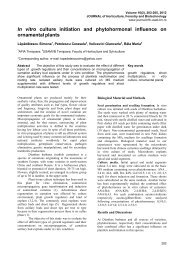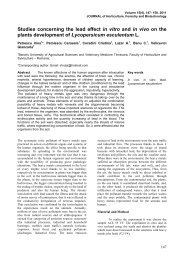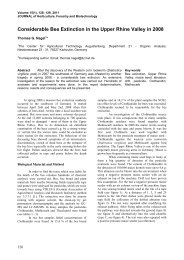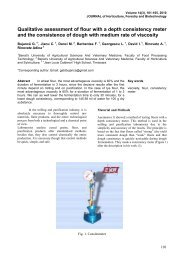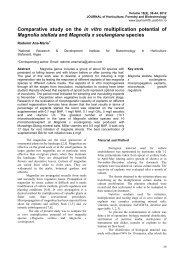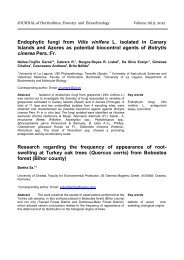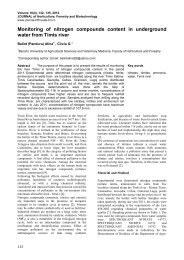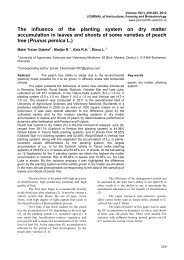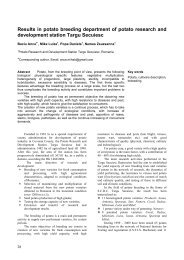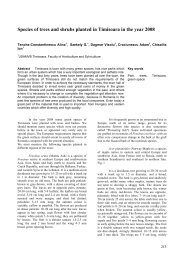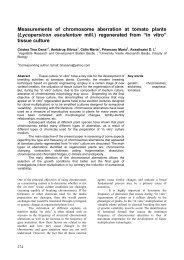zones, the <strong>compaction</strong> <strong>in</strong>dex was calculated. It is theratio <strong>of</strong> the three <strong>compaction</strong> zones located on the<strong>in</strong>terval between tree rows and <strong>compaction</strong> zonesituated on the tree row axis. Thus the follow<strong>in</strong>ggraduations <strong>of</strong> experimental C factor were established:A- Interval between two tree rows.1. Weakly compacted zone (tree row);2. Strongly compacted zone (wheel trace placed <strong>in</strong> the lower part <strong>of</strong> the <strong>in</strong>terval between two tree rows)3. Strongly compacted zone placed <strong>in</strong> the upper part <strong>of</strong> the <strong>in</strong>terval between two tree rows;4. Medium compacted zone (middle distance <strong>of</strong> the <strong>in</strong>terval between two tree rows;Fig. 1. Location <strong>of</strong> the four <strong>soil</strong> <strong>compaction</strong> zones between two tree rowsc1 = the ratio between strongly compactedzone situated on the wheel trace located downstream <strong>of</strong>the <strong>in</strong>terval between tree rows and weakly compactedzone located on the tree row axis – <strong>compaction</strong> <strong>in</strong>dex 1(CI 1 );c2 = the ratio between medium compactedzone located <strong>in</strong> mid-<strong>in</strong>terval between tree rows andweakly compacted zone situated on the tree row axis -<strong>compaction</strong> <strong>in</strong>dex 2 (CI 2 );c3 = the ratio between strongly compactedzone situated on the trace located upstream <strong>of</strong> the<strong>in</strong>terval between tree rows and weakly compacted zonelocated on the tree row axis – <strong>compaction</strong> <strong>in</strong>dex 3(CI 3 ). These three <strong>in</strong>dices were calculated for each <strong>of</strong>the three physical properties analyzed. Therefore, toidentify them, physical property short name wasattached to each <strong>of</strong> them.Soil samples were taken, <strong>in</strong> 4 replications, frompr<strong>of</strong>iles located on each <strong>compaction</strong> zone <strong>in</strong>dicated <strong>in</strong>Fig. 1. Samples unchanged <strong>in</strong> structure, were collectedon depths <strong>of</strong> 5-10 cm, 15-20 cm, 35-40 cm and 55-60cm. It was determ<strong>in</strong>ed the bulk <strong>density</strong> (BD), thesaturated hydraulic conductivity (K sat ) and resistance topenetration (RP).Results and Discussion‣ Influence <strong>of</strong> experimental factors onthe value <strong>of</strong> ratios between the technologicaltraffic zones concern<strong>in</strong>g the physical propertiesanalyzedOn average, on the 2 periods <strong>of</strong> time from treesplant<strong>in</strong>g, the average <strong>of</strong> the 3 <strong>compaction</strong> <strong>in</strong>dices (CI 1 ,CI 2 and CI 3 ) <strong>of</strong> bulk <strong>density</strong> (BD) on the SEE and ET<strong>soil</strong>s versus ECC <strong>soil</strong>, were significantly <strong>high</strong>er by 6-8% on depths <strong>of</strong> 15-20 cm and 35-40 cm and nonsignificant on 55-60 cm depth. Instead, on the depth <strong>of</strong>5-10 cm, ECC - SEE <strong>soil</strong>s , versus TE <strong>soil</strong>, the average<strong>of</strong> the same three <strong>compaction</strong> <strong>in</strong>dices <strong>of</strong> bulk <strong>density</strong>were significantly <strong>high</strong>er by 10%. Under the sameconditions, the value <strong>of</strong> the three <strong>compaction</strong> <strong>in</strong>dices <strong>of</strong>saturated hydraulic conductivity (K sat ), on the ET <strong>soil</strong>,versus SEE <strong>soil</strong> was three times significantly <strong>high</strong>er atthe depth <strong>of</strong> 5-10 cm and 1.75 times at the depth <strong>of</strong> 15-20 cm. Also, on the depth <strong>of</strong> 15-20 cm, on ECC <strong>soil</strong>versus the SEE <strong>soil</strong>, the value <strong>of</strong> the three <strong>compaction</strong><strong>in</strong>dices <strong>of</strong> K sat was seven times significantly <strong>high</strong>er.Compared to the value <strong>of</strong> the three <strong>compaction</strong> <strong>in</strong>dicesrelated to BD and K sat , the same <strong>in</strong>dices value relatedto resistance to penetration (RP) not significantlydifferentiated the three <strong>soil</strong> types at any <strong>of</strong> the four <strong>soil</strong>depths analyzed.On average, on the three <strong>soil</strong> types, <strong>in</strong> 4th yearafter trees plant<strong>in</strong>g versus 20th year, on the depth <strong>of</strong> 5-10 cm, the value <strong>of</strong> the three <strong>compaction</strong> <strong>in</strong>dicesrelated to BD was significantly <strong>high</strong>er by 10% and thethree <strong>compaction</strong> <strong>in</strong>dices related to RP by 74%.Instead, <strong>under</strong> the same conditions, on the depth <strong>of</strong> 55-218
60 cm, the three <strong>compaction</strong> <strong>in</strong>dices related to BD wassignificantly reduced by 9%, and those related to RP,by 71%. The values <strong>of</strong> <strong>compaction</strong> <strong>in</strong>dices related toK sat have registered <strong>in</strong> l<strong>in</strong>e with those presented above,respectively the <strong>compaction</strong> <strong>in</strong>dices related to the bulk<strong>density</strong>. Thus, on the 15-20 cm depth, the value <strong>of</strong>three <strong>compaction</strong> <strong>in</strong>dices related to K sat wassignificantly greater with 326% at 20 years s<strong>in</strong>ce treesplant<strong>in</strong>g compared to the 4 year period s<strong>in</strong>ce theirplant<strong>in</strong>g.On average, on the three <strong>soil</strong> types and the twoperiods <strong>of</strong> time from trees plant<strong>in</strong>g, except the depth <strong>of</strong>5-10 cm, on the other three <strong>soil</strong> depths analyzed CI 1and CI 3 , versus CI 2 , related to the BD and PR recordedgenerally significantly <strong>high</strong>er values and respectivelylower concern<strong>in</strong>g K sat .Influence <strong>of</strong> technological traffic on the <strong>soil</strong> <strong>compaction</strong> state <strong>in</strong> a <strong>high</strong> <strong>density</strong> <strong>apple</strong> <strong>orchard</strong>Table 1ReportedB FactorA Factor graduastionsSoil depth <strong>soil</strong>graduastionsC Factor graduastions(cm) physicalLSD5LSD5a1 a2 a3b1 b2property%%c1 c2 c3 LSD%5-10 1 1,22 1,21 1,10 0,065 1,23 1,12 0,071 1,18 1,15 1,19 NS2 0,46 0,40 1,20 0,545 0,65 0,72 NS 0,58 0,80 0,69 NS3 4,40 3,19 2,74 NS 4,38 2,51 0,798 3,88 2,89 3,56 0,56415-20 1 1,03 1,12 1,10 0,051 1,11 1,06 NS 1,11 1,07 1,06 0,042 4,71 0,67 1,17 2,84 0,83 3,54 1,97 2,13 2,35 2,07 NS3 2,36 2,25 2,56 NS 2,76 2,02 NS 2,68 2,24 2,25 NS35-40 1 1,05 1,12 1,10 0,057 1,06 1,12 NS 1,07 1,07 1,12 0,0372 1,05 0,55 1,16 NS 0,92 0,92 NS 0,82 1,28 0,66 0,3753 2,07 2,34 2,04 NS 1,77 2,52 0,295 2,05 1,85 2,54 0,34155-60 1 1,06 1,12 1,11 NS 1,05 1,14 0,075 1,12 1,11 1,06 0,0342 0,98 0,44 0,68 NS 0,91 0,50 NS 0,79 0,78 0,54 NS3 1,51 1,94 2,19 NS 1,39 2,37 0,407 2,14 1,62 1,90 0,315Soil physical property: 1= bulk <strong>density</strong>; 2= Saturated hydraulic conductivity; 3= resistance to penetrationThe significance <strong>of</strong> A, B, C experimental factor graduations is presented <strong>in</strong> chapter „Material and Method”‣ Influence <strong>of</strong> <strong>soil</strong> type on the value <strong>of</strong>ratios between the technological trafficzones concern<strong>in</strong>g the physical propertiesanalyzed. (Interaction <strong>of</strong> experimentalfactors A/C)For the three <strong>soil</strong> physical properties<strong>in</strong>vestigated and four <strong>soil</strong> depths analyzed, the number<strong>of</strong> cases <strong>in</strong> which the three <strong>compaction</strong> <strong>in</strong>dices weresignificantly different between them was the <strong>high</strong>est onECC <strong>soil</strong> (30.6% <strong>of</strong> cases analyzed ) followed by TE<strong>soil</strong> (25%), and SEE <strong>soil</strong> was located on the last place(19%). For the three <strong>soil</strong>s and four depths analyzed, thenumber <strong>of</strong> cases <strong>in</strong> which the three <strong>compaction</strong> <strong>in</strong>diceswere significantly different was the <strong>high</strong>est (28% <strong>of</strong>cases analyzed) for BD, followed by RP (25%) and K satwas on the last place (22%). For the three <strong>soil</strong> typesand the three physical properties analyzed, the number<strong>of</strong> cases <strong>in</strong> which the three <strong>compaction</strong> <strong>in</strong>dices weresignificant different was equal at 35-40 cm and 55-60cm depths (30% <strong>of</strong> cases analyzed ) followed by 5-10cm depth (26%), and 15-20 cm depth was located onthe last place (15%) - Table 2For the three <strong>soil</strong> physical properties studied andthe four <strong>soil</strong> depths, <strong>compaction</strong> <strong>in</strong>dex 2 recorded the<strong>high</strong>est number <strong>of</strong> cases <strong>in</strong> which it was significantlydifferent between the three <strong>soil</strong> types exam<strong>in</strong>ed (17%<strong>of</strong> the total number <strong>of</strong> cases). Under the sameconditions, the <strong>compaction</strong> <strong>in</strong>dices 2 and 3 registeredan equal number <strong>of</strong> cases that have significantdifferences, only 11%.For the four <strong>soil</strong> depths analyzed, the number <strong>of</strong>cases <strong>in</strong> which the three <strong>in</strong>dices <strong>of</strong> <strong>compaction</strong> weresignificantly different between the three <strong>soil</strong> types wasrecorded for BD (31% <strong>of</strong> the total number <strong>of</strong> cases)followed by K sat (8%). Under the same conditions, the<strong>compaction</strong> <strong>in</strong>dices related to RP were not significantlydifferent <strong>in</strong> any case (Table 2).For the three physical properties studied, thenumber <strong>of</strong> cases where the <strong>compaction</strong> <strong>in</strong>dices weresignificantly different between the three <strong>soil</strong> typesoccurred at the 5-10 cm shallow depth (22% <strong>of</strong> casesexam<strong>in</strong>ed). On the depths <strong>of</strong> 15-20 cm and 35-40 cm,this number was similar, represent<strong>in</strong>g 15% <strong>of</strong> the totalnumber <strong>of</strong> calculated cases. At 55-60 cm depth, therewas no case <strong>of</strong> significant differentiation <strong>of</strong> the three<strong>compaction</strong> <strong>in</strong>dices (Table 2).219



